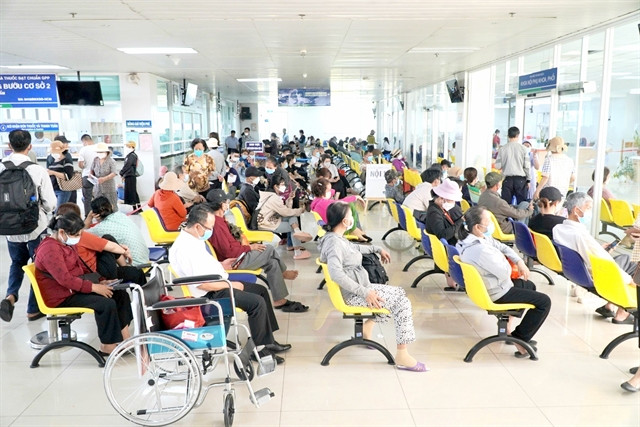 |
| Patients waiting at HCM City's Oncology Hospital. VNA/VNS Photo |
Many patients say they are not satisfied with the service quality of medical check-up departments at public hospitals in HCM City.
According to the survey conducted by the city’s Department of Health, more than 12,500 people questioned showed dissatisfaction, increasing nearly 18.5 per cent compared to the same period in 2022.
The quality of toilets, which has been improved after complaints for many years, continued to be rated bad with the dissatisfaction rate increasing by 30 per cent.
Other problems that lower the patient’s satisfaction at State-owned hospitals in HCM City are procedures for check-ups covered by health insurance, instructions and seats for patients in the waiting area.
In the survey, many patients said there are too many steps, from health check-up to getting medicine with complicated procedures and unfriendly attitude of medical workers.
Kinh Tế&Đô Thị (Economic and Urban Affairs) cited one comment saying that the patient had to go to the hospital from early morning and waited until the afternoon to get the health check-up result and wait for medicine.
Dr Nguyễn Trọng Khoa, deputy head of the Department of Medical Service Administration under the health ministry, said through the survey, public hospitals in HCM City have been aware of their current problems and what to improve, adding that patients did not raise their voices in the survey, the hospitals would not have known the problem.
The city’s Department of Health has asked public hospitals to find solutions to improve the quality and reduce the dissatisfaction rate, including shortening procedures, improving the serving attitude of medical workers and reducing waiting time for testing results.
Since 2017, health check-up departments at the city’s public hospitals have been equipped with automatic survey machines on patient satisfaction.
According to medical experts, there are two stages that determine the level of patient satisfaction of the people: the reception staff and the doctors.
Associate Professor Hoàng Thị Diễm Tuyết, director of Hùng Vương Hospital, said quality improvement is considered a vital task in developing autonomous hospitals.
She said when hospital quality is improved, patient satisfaction will improve as well and medical complaints will be reduced. This is the core to improve the hospital reputation and increase the number of patients. It helps increase the hospital's revenue to improve staff income and reinvestment.
According to a survey of the health ministry, 70 per cent of patient calls for the Hà Nội Obstetrics and Gynecology Hospital have been well received. The hospital has also received patient feedback through QR codes, mailboxes or at counters.
Mai Trọng Hưng, deputy director in charge of the hospital, said improving quality must be substantive and come from the hospital's internal resources.
The hospital’s quality improvements focus on professional quality, patient satisfaction, facilities, medical equipment and medical staff morale. If there is any negative feedback, the hospital’s Quality Management Department will discuss with other professional departments to analyse the reasons and come up with solutions.
Measuring patient satisfaction at hospitals nationwide has been carried out for more than 10 years based on surveys.
According to the Department of Health Care Management, Ministry of Health, in 2023, there were more than one million survey feedbacks updated on the database. HCM City, Hà Nội and Đắk Lắk had the highest number of feedbacks.
Dr Khoa from the Department of Medical Service Administration Medical Examination, said surveying patient satisfaction aims not only to assess how much percentage of people are satisfied with medical services, but also to assess the issues that people are not satisfied with, so that medical facilities can find the cause and solutions towards the goal of serving patients better.
The surveys cover many areas, but patients are often frustrated about the medical treatment process, waiting time, information exchange between medical staff and patients and among patients, he said.
“Quality improvement should start from the smallest things such as hospital toilets, walkways, electricity and water to technical expertise,” he said. VNS